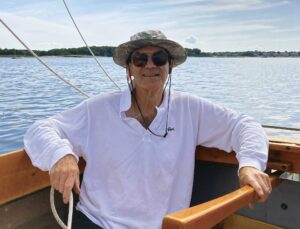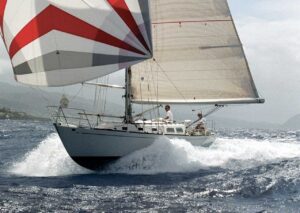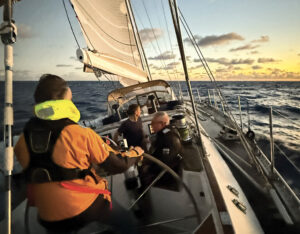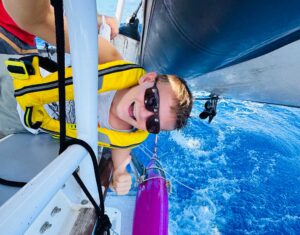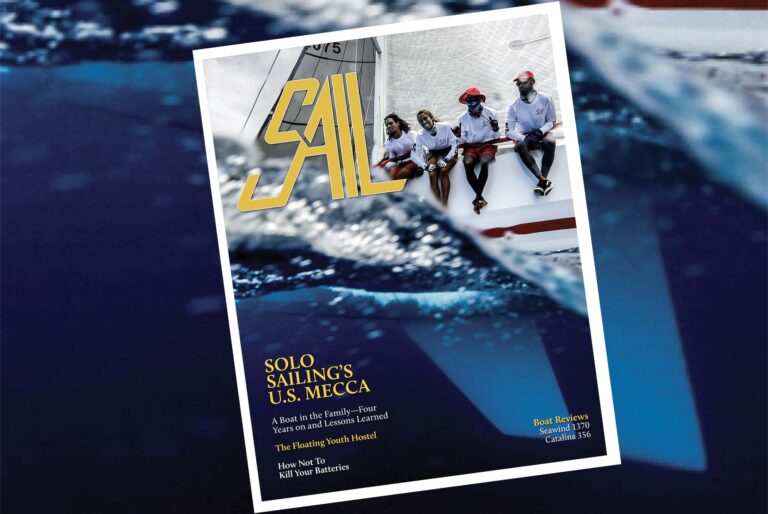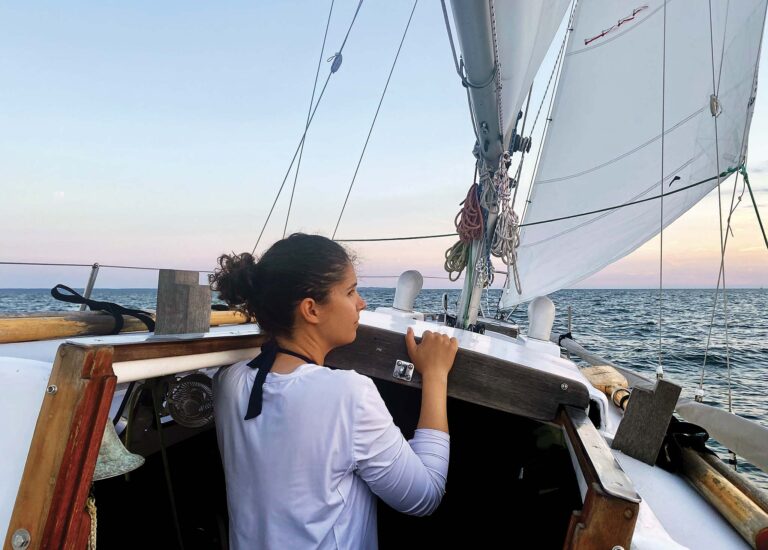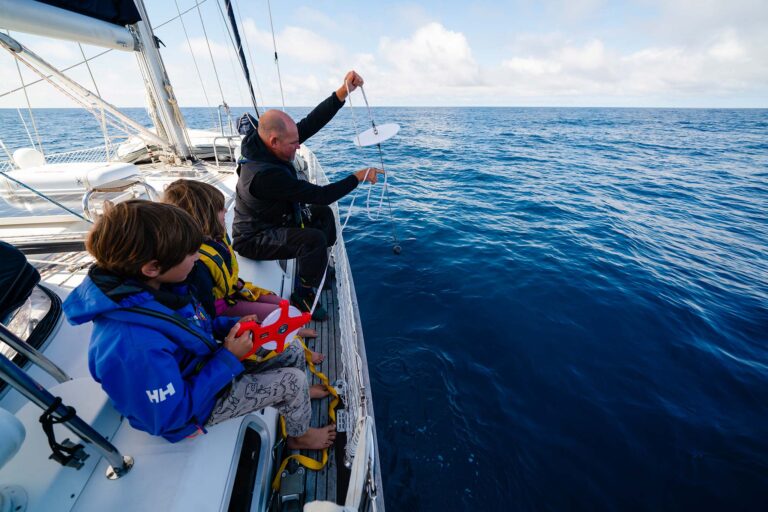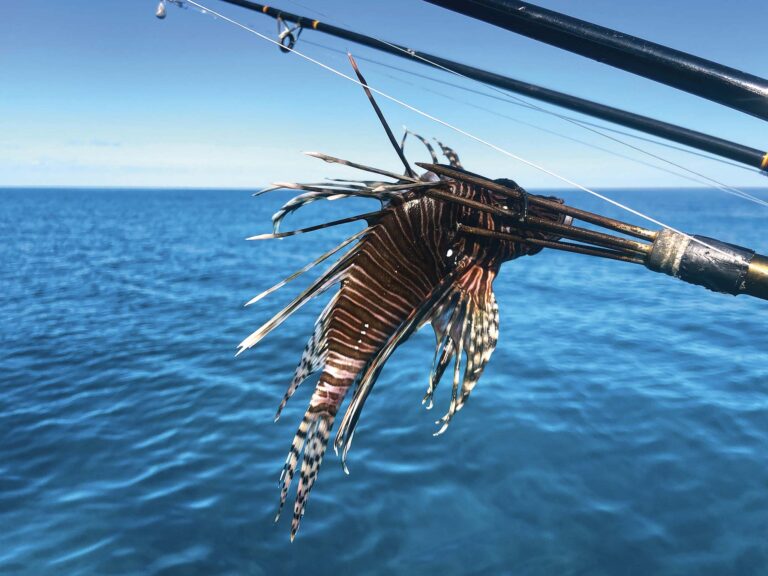Every sailor has a Covid story, many involving themselves—or their boats—getting stuck where and when they least expected.
I am willing to bet, however, that few of them sound like this:
2/5/2020
I finish every day absolutely filthy. Not just sweat, but dirt sticking to every sweaty bodily surface—which is every surface. We’re a degree from the equator and don’t have AC. Streaked in with the dirty sweat is grease, because every conceivable thing on deck—cables, stays, ratchets, hatches—is coated in grease to keep the whole boat from coming to a rusty screeching stop. Finish off this so-far enviable skincare routine of sweat, dirt, and grease with massive amounts of sunscreen and splashes of saltwater, and this combination is me at the end of every day. The good news is we have a watermaker and can take daily showers. The other good news is I look in the tiny mirror hanging in the galley only about once a week.
In January of 2020 I flew to Hawaii to start a new job—first mate on the Kwai, a 140-foot ketch-rigged sailing ship running cargo from Hawaii to the Kiribati Line Islands. It was my first position as mate and also my first time working with cargo. I had just come from working on a beautiful sailing yacht, and upon arrival I was appalled—by the safety standards, the under-maintained condition of the boat, but most of all by my anxiety levels over my new responsibilities. I was learning cargo operations on the run, learning a new boat, and learning to manage a crew that was made up of Kiribati men with varying levels of English proficiency, all of whom knew both the boat and cargo game better than I did. As we loaded cargo in Hawaii preparing for what was called Voyage 52, I was thrilled for the upcoming adventure—and mildly nauseated by my own inadequacies. And yes; I kept a journal.

2/11/2020
Two days of sustained 20+ knot wind has built up the sea state, and the ocean washes over the boat as well as surrounds it. The boys took baths in the leeward scuppers, and while eating at the deck-bolted picnic table on the aft deck we all automatically lift our feet when we hear a wave slap the hull and watch the seawater race across the deck planks below us…
While I was new, the Kwai had been doing this work for 15 years. Originally a German fishing boat built in 1950, she was bought by Brad Ives in the early 2000s and brought to Hawaii, where he outfitted her with a ketch rig and started a cargo business. The progeny of a long line of New England sea captains, including a direct descendant of Nathaniel Bowditch, Brad had been sailing the Pacific for a number of years already. With her cargo of first-world goods that are extremely difficult to come by on remote Pacific islands, Kwai by 2020 had become an important link with the global world for the Kiribati Line Islands. Not only was Kwai their main importer of everything except bulk food items like rice and flour, she employed a rotating pool of Kiribati men as deck crew. It was considered a great job for them, well-paying and with the benefit of trips to Hawaii for shopping. Conversely, by employing Kiribati as deck crew, the ship kept its own costs down and strengthened ties and loyalty with the people it served. The officers—captain, mate, engineer, supercargo and chef—were all assorted westerners. During my time aboard, all of the officers except Willy, the engineer, were women.

2/20/2020
The Kiribati Line Islands. Three islands right above the equator, 1,000 miles due south of Hawaii and outliers from the rest of the island nation of Kiribati, which lies nearly 2,000 miles to the west. (That weird kink in the international date line in the Pacific? That’s to keep all of the Kiribati islands in the same day.)
Christmas Island, spelled Kiritimati. (In the Kiribati language they don’t have the letter “s.” The sound is written with a “ti.” Read Kiritimati again with that in mind. This also informs the pronunciation of Kiribati—phonetically “Kiribas.”). This is where the airport is in a town called Banana, but London is right down the road and Paris is just across the bridge. If you feel like a drive, you can hit Tennessee and Poland on your loop of the island.
Fanning Island (or Tabuaeran). Where the guys took me to a kava/karaoke bar and tried to get me to sing—but they don’t have a screen to show the words. The men all have their songs so down pat they just close their eyes and mournfully sing what they told me are mostly Kiribati love songs. And by men—we show up at the sand-floor, palm-frond-thatched-roof, wall-less “bar” and I look around at the eight or so tables of a dozen men each—not a woman as far as the eye can see. It was a good moment, standing there with my toes in the sand wondering the extent of the cultural faux pas I was making. I was brought a coconut, and endless baby cups of kava; was whupped resoundingly at pool, and declined singing on the excuse that I didn’t know the words to “Have You Ever Seen the Rain.” I slept ashore that night at a “hotel”—my five Australian dollars got me a palm-frond-enclosed platform in the front of Kabi’s cousin’s aunt’s brother’s fiancé’s yard. In the morning, I walked back to the boat at sunrise, lagoon on one side, ocean barely more than a stone’s throw on the other.
And Washington Island (Teraina). Where we floated just offshore for two days because the anchor wouldn’t hold in the coral, while small boats ran the cargo to and from the beach, our crane guy skillfully lifting drums of oil and pallets of cargo from the moving ship to the bouncing small boats alongside without smashing cargo or people. My self-appointed position was catching and receiving painters, signaling the crane operator, and keeping both cargo and empty hook under some sort of control as it went from Kwai to bobbing small boats and back. Absolute chaos, but…these guys are good. And safety standards are nonexistent.

While a novel occurrence in the 21st century, Sail Cargo is not unique to the Kwai. Environmental concerns are making the idea of a globalized world run on sustainable energy more and more attractive, and as sailors we are well aware of the power of the wind. Initiatives to reintroduce sustainable shipping are making a comeback, examples being Sail Cargo Inc. in Costa Rica, Schooner Apollonia on the Hudson River, and Fairtransport’s The Tres Hombres out of the Netherlands. As sailing is neither particularly fast nor particularly lauded when trying to stick to a schedule, it is hard to make these initiatives competitive with standard shipping, especially when sailing boats—even those with large cargo holds—can carry a fraction of what container ships can. Brad Ives was savvy enough to find a niche for the Kwai where her route took her across the trades in both directions, and she was truly important to the communities she served.
3/15/2020
We arrived back in Honolulu at the close of Voyage 52, battered, salty, and limping slightly with our three torn sails after our dogged fight to get north from Fanning Island. The wind kept increasing and turning more north on us, and we had to pinch the whole way to end up in Hawaii and not Siberia. The last day about summed up Voyage 52—10 miles away from beautiful, sheltered Oahu, the island a coy mirage playing peek-a-boo from behind rainstorms while loftily refusing to come closer with anything resembling alacrity or even reasonable quickness, we fought our way into a headwind gusting sometimes 50 knots, our speed a sad and grueling 3. And then a jib sheet block exploded, adding a torn-up jib clew to our list of repairs…
And the week since in Hawaii has flown past, filled with loading, repairs, and what personal time could be snatched for internet and shopping. We took the mizzen sail and the jib off and brought them over to the warehouse where they made the acquaintance of the ancient and industrial sewing machine. Myself, Iakobwa, Ieie, and Frank spent two days wrestling massive areas of canvas through the small runway of the sewing machine, the unstoppable forward march of the needle stemmed depressingly often because we couldn’t get our thread tension right and it kept breaking. Meanwhile, back on board our resident welder, Kabi, set to work on some deck projects—freeing the rust-frozen freeing ports, fixing small holes, and replacing tangs along the deck rail. Banu and Arioka replaced halyards and blocks, Captain Anika found time to replace the shattered window in the wheelhouse, Cook Jane rushed about buying massive food orders for us and for customers, Supercargo Chantale did lots of mysterious and important paperwork, Engineer Willy replaced steering tubes, machined an aluminum main clew reinforcement, and did oil changes. It was a busy few days, culminating yesterday morning in replacing the slewing gear (steel cables that help control the cargo boom) and finishing minutes before we cast off to to sail south and begin Voyage 53. Willy barely made it back on board after last minute shopping for outboard spares. Meanwhile, Honolulu is buzzing with talk of some rampant virus…

While Kwai’s Voyage 52 was marked by extremely difficult conditions, equipment failures, and a breakneck schedule (and for me, personally, learning the ropes at top speed), Voyage 53 became its own kind of odyssey, as we swapped tidbits gleaned from emails about the degenerating state of a world descending into what was turning out to be a global pandemic, and endlessly discussed how we should react. The original plan was to service the Kiribati Islands and then continue past to the Cook Islands; however, the Cook Islands was one of the first countries to shut its borders down. As we revised our plans, moving between the virus-free Kiribati Islands and continuing to do cargo ops while receiving hundred-character emails from families stuck in a post-apocalyptic lockdown world, the “normalcy” of the world we had left behind increasingly lost its meaning.
4/3/2020
We are underway to Fanning. I just got off watch. It is a moonless night, but the stars are happy for it. There was singing on the aft deck earlier, but now all I hear is the occasional crying of a passenger’s baby forward, and the shush of the waves.
The world is a very weird place right now, I think. And weirder still, my assumptions of it, my experience of it, is all through gossip traded among the crew from the emails we’ve gotten from family and others. We are affected in that our schedule keeps changing. As borders are shutting, the day-to-day reality of being on a cargo boat in the middle of the Pacific stays the same, but our destinations change, and decisions as to whether or not to stay on the ship and continue to weather this changing schedule, or catch what might be the last flight (to Hawaii…and from there home or…elsewhere? Anywhere?) are looming. It is a hard decision, because as I said…I don’t really know the reality in the States right now. In Europe. Pretty much everywhere and anywhere else in this very impacted, very globalized world. Hearsay, and rumors, and emails, and headlines. What’s happening out there? Do I want to know? Do I want to go back?
Meanwhile my reality. The reality of sunrises and sunsets over tropical islands and endless horizons, the reality of the constant noise and music and laughter and singing of Kiribati culture, the reality of being so filthy at the end of each day I take my clothes into the shower with me to rinse them out. The reality of a cabin that is so hot that my chocolate stash is a melted ruin. The reality of rain showers and millions of stars. The reality of waking up each morning and being ready to spend the next 12 hours creating order out of chaos as myself and 8 to 12 Kiribati guys with varying English play Tetris loading and unloading the ship of everything from USB cards to 40 tons of copra (dried coconut) to 300 drums of petrol to diapers. Flour. Soda. Car batteries. Oh, but make sure the lumber is accessible for Fanning but the water tanks have to be lashed but the totes can’t be under the copra and we need to access under the foc’sle for when we get to Christmas but THOSE DRUMS CANT GO THERE THE PLYWOOD HAS TO BE ACCESSIBLE passengers coming in 10 make sure the tarps are up USE A STERN LINE you to the foc’sle please make sure everything’s lashed NO not those bikes those are Washington Island BOOM UP BOOM UP this water tank needs to be turned so we can fit those two pallets here but that clothing bale needs to be accessible tomorrow move it first DOWN DOWN DOWN when you have a sec change the top block on the mizzen lazy jacks USE A HOT KNIFE great how’s everyone doing OK breathe. Breathe. Chug another full water bottle. Laugh. Tease the guys. Back to work.

They know the game and I’m learning the game and quite often Anika, the captain, steps in if I’m flustered and overwhelmed but still…It’s a lot. The reality of managing chaos, or playing stresstris, as I’ve started calling it. I’m learning a ton, and I think I’m getting better.
The reality of dolphins breathing around the boat at night.
Not only would the Kwai transport cargo from Hawaii down to the Kiribati Islands, she would typically transport cargo between the three islands. After arriving in Christmas Island, we would unload the portion of the hold delegated to that island, and then load that space back up with staples such as rice and flour. Container ships would stop at Christmas, but Kwai was the ship that distributed these goods on to the more remote Fanning and Washington. As we unloaded and created space in the hold at Fanning and Washington, we would take on copra—Kiribati’s main export. We would also take human passengers between the islands. Passengers were messy, chaotic, heartwarming, and stressful.
4/10/2020
I love the music. Everyone here sings, everyone. It is the go-to social activity. Karaoke at the bar, music while they work, grab a guitar or a ukulele on a work break or a cava night and everyone will join in, filling the bass parts, altos, leads, tenors, and harmonies. I love to sing and love being in a culture where it is enjoyed and appreciated when I do—and better yet, I can sing songs they don’t know the words to—and they don’t know that I don’t, either!
They worry here that they will run out of food. They rely on the staples being brought to Christmas Island by cargo ship but are terrified of a ship bringing the virus—they would have no defense. There are fish and coconuts, but not at a level to support the current populations. While the rest of the world panics about the stock market and toilet paper, here they worry about running out of food. And once Kwai leaves for Hawaii, she will not be allowed back. That means that whichever of the crew come with us for the trip north will not be allowed back home for the foreseeable future. A hard choice. The guys need money, but they don’t want to be willingly separated from their families.

And for me. I need to figure out if I’m staying on the boat or trying to catch what might be the last flight back to civilization. The world out there sounds like a crazy place.
I had a couple hours’ breathing time this afternoon and was given leave to go to shore—first time I’d set foot on Washington Island. It’s INCREDIBLE. Green grasses in the clearings under arcing coconut palms, separated from the blue water by a snaking ribbon of white sand. The palms were so dense in places it was almost dark under them, their roots drinking from canals of brackish water that reflect the sky. Washington has a freshwater lake at the center, someone told me the only Pacific atoll to do so. A bumpy dirt two-track runs along the inside of the tree line parallel the beach, and as I walked along, Kiribati on bikes or motorcycles would ride past, usually two to a motorbike, and we smile at each other and say “Mouri!” Back at the loading spot 30 kids were playing semi-naked in the water. They all came running when I pointed my camera at them, and then climbed aboard my boat when I caught a lift back to the ship. I teased them that they were strong and would help us unload, and then had to deal with getting a riot of eager flexing children off the Kwai. Ooops! It was beautiful.
Mid April of 2020 Kwai sailed north back to Hawaii. Of the five Kiribati crew who were supposed to sail north, on the morning of our departure from Christmas Island one showed up at the boat ashen-faced, announcing he could not leave his family. It was an impossible decision in a world filled with impossible decisions, and was respected. The rest of us, including the four Kiribati who did come, sailed north to Hawaii where I also left the boat to be with my family.
Kwai continued on in the next months doing ocean clean up, using her crane and cargo hold to pick ghost nets out of the great Pacific garbage patch. In 2021 she was sold to the Marshall Islands, where she continues to be used as an environmentally friendly transport ship, helping to meet the Marshall Islands’ target of reaching net-zero greenhouse gas emissions by 2050.
Sailing with Kwai in the early months of 2020 was one of the most surreal and vivid chapters of my life. Not only because the world was changing, and I was living it through an experience of cargo ops on flat, improbable, coconut-covered islands in the middle of the Pacific. It was also a time when I was surrounded by another culture during global turbulence, and not as a tourist or a visitor, but as someone who worked and sweated and sang every minute of every day alongside them while we breathed life into the common purpose that was the ship. Covid upended the world. But in the three short months I sailed and worked in the insular, semi-controlled chaos that was Kwai, the ship kept my world whole.

January/February 2025


